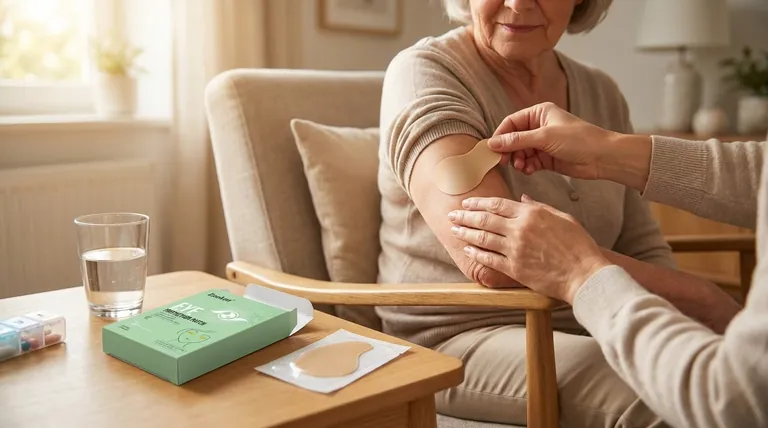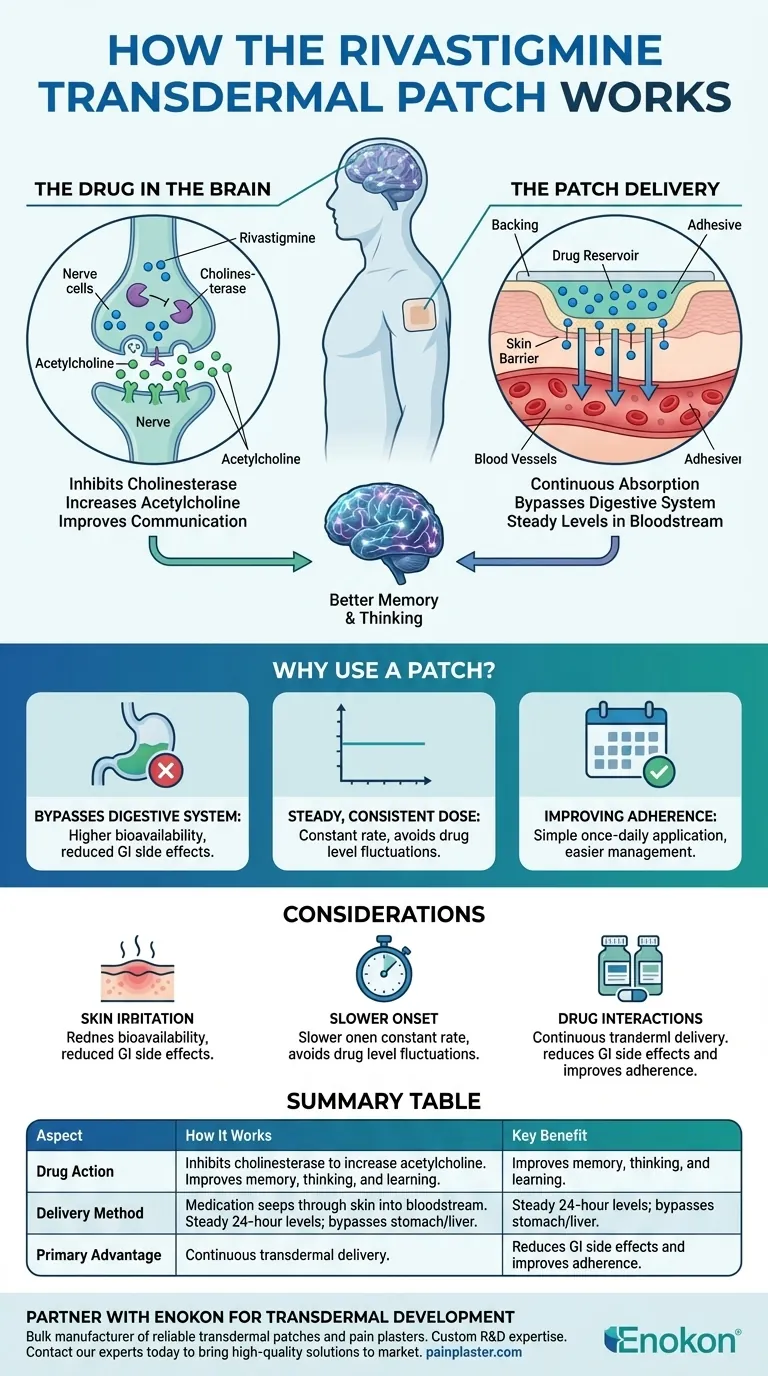In short, the rivastigmine transdermal patch works by delivering medication through the skin to treat dementia. The patch contains the drug rivastigmine, a cholinesterase inhibitor that increases the amount of a natural substance in the brain responsible for memory and thinking. This transdermal system provides a steady, continuous dose directly into the bloodstream, bypassing the digestive system.
The core advantage of the rivastigmine patch is its delivery method. By absorbing the drug through the skin, it provides a consistent therapeutic level, avoids the breakdown of medication in the stomach and liver, and can reduce certain side effects associated with oral forms.

The Two-Part Mechanism: The Drug and The Delivery
To understand how the rivastigmine patch functions, you must look at two distinct but cooperative components: the medication itself and the patch that delivers it.
How Rivastigmine Works in the Brain
Rivastigmine is a class of drug known as a cholinesterase inhibitor.
Its purpose is to increase the levels of a specific neurotransmitter (a brain chemical) called acetylcholine. This substance is crucial for communication between nerve cells and plays a vital role in memory, thinking, and learning.
In conditions like Alzheimer's and Parkinson's disease dementia, the brain produces less acetylcholine. Rivastigmine works by blocking the enzyme that naturally breaks down this chemical, thereby increasing its availability and helping to improve mental function.
How the Transdermal Patch Works on the Skin
The patch is a sophisticated medical device designed for controlled drug release.
It is constructed in layers, including a backing, a drug reservoir containing the rivastigmine, and a medical-grade adhesive. Once applied to the skin, the medication slowly seeps from the reservoir, crosses the skin barrier, and enters the small blood vessels below.
From there, the circulatory system carries the drug throughout the body and to its target site in the brain. This process ensures a slow, sustained release of medication over a 24-hour period.
Why a Patch Is Used for Rivastigmine
The choice of a transdermal patch over a traditional pill is a deliberate strategy to overcome specific challenges and improve the therapeutic outcome.
Bypassing the Digestive System
When a medication is taken orally, it must pass through the stomach and liver before entering the bloodstream. This process, known as first-pass metabolism, can break down a significant portion of the drug, reducing its effectiveness.
The patch bypasses this entire system, leading to higher bioavailability—meaning more of the active medication reaches the brain. This also helps reduce common gastrointestinal side effects.
Ensuring a Steady, Consistent Dose
Oral medications can create peaks and troughs in drug concentration in the blood, leading to fluctuating effects.
A transdermal patch, however, delivers the drug at a near-constant rate. This steady state helps maintain consistent cognitive benefits and can reduce the risk of side effects associated with high peak concentrations.
Improving Medication Adherence
Remembering to take multiple pills a day can be a significant challenge, especially for individuals with dementia.
The patch simplifies this process immensely. Applying one patch a day is far easier to manage, reducing the chances of missed doses and ensuring the continuity of treatment.
Understanding the Trade-offs and Considerations
While the patch delivery system offers clear advantages, it's essential to be aware of the potential downsides and necessary precautions.
Potential for Skin Irritation
The adhesive and the medication itself can sometimes cause redness, itching, or irritation at the application site. This is a common side effect for most transdermal patches.
Slower Onset of Action
Because the medication must be absorbed through the skin, the therapeutic effects are not immediate. It takes time to build up a consistent level of the drug in the bloodstream.
Potential for Drug Interactions
Like any medication, rivastigmine can interact with other drugs. It is critical to provide your doctor and pharmacist with a complete list of all medications you are taking to avoid harmful interactions.
Making the Right Choice for Your Goal
Selecting a treatment method depends on balancing efficacy, side effects, and practical usability for the individual patient.
- If your primary focus is reducing gastrointestinal side effects: The patch is an excellent choice, as it completely bypasses the stomach and liver.
- If your primary focus is simplifying the daily medication routine: The once-daily patch offers a clear advantage over multiple oral doses, especially for patients with memory impairment.
- If your primary focus is managing potential skin sensitivity: Careful rotation of the application site and monitoring for irritation are necessary when using the patch.
Ultimately, understanding how the patch combines a proven brain-acting medication with a superior delivery system empowers you to have a more informed discussion with healthcare providers about the best path forward.
Summary Table:
| Aspect | How It Works | Key Benefit |
|---|---|---|
| Drug Action | Inhibits cholinesterase enzyme to increase acetylcholine in the brain. | Improves memory, thinking, and learning. |
| Delivery Method | Medication seeps from patch reservoir through skin into bloodstream. | Provides steady, 24-hour drug levels; bypasses stomach/liver. |
| Primary Advantage | Continuous transdermal delivery. | Reduces GI side effects and improves medication adherence. |
Partner with Enokon for Your Transdermal Patch Development
As a bulk manufacturer of reliable transdermal patches and pain plasters, Enokon provides healthcare and pharma distributors and brands with the technical expertise for custom R&D and development. Benefit from our proven delivery systems to create effective, patient-friendly treatments like the rivastigmine patch.
Contact our experts today to discuss your project and learn how we can help you bring high-quality transdermal solutions to market.
Visual Guide

Related Products
- Herbal Eye Protection Patch Eye Patch
- Far Infrared Heat Pain Relief Patches Transdermal Patches
- Far Infrared Deep Heat Relief Patches Medicated Pain Relief Patches
- Heating Pain Relief Patches for Menstrual Cramps
- Menthol Gel Pain Relief Patch
People Also Ask
- Can under eye patches smooth fine lines and wrinkles? Hydrate & Plump for Youthful Skin
- What are the main benefits of using eye patches in a skincare routine? Revitalize Your Under-Eye Area
- What factors should be considered when purchasing eye patches? Essential Guide for Safe & Effective Use
- How can using eye patches contribute to a self-care skincare routine? Boost Hydration & Relaxation
- How do eye patches enhance the effectiveness of eye creams? Boost Your Eye Care Routine














